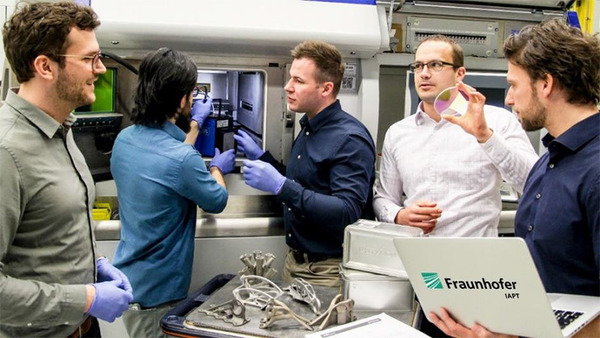Hussein Tarhini works with Stefan Grottker, MSc in Optical Engineering and Project Engineer, in the Quality Assurance and Certification working group at Fraunhofer IAPT. The approach of these experts at Fraunhofer IAPT clearly takes a step in the direction of preventive measurements and big data: The highly complex AM process with over 100 potential influencing variables requires the systematic monitoring and collection of those values. The data can then be interpreted using artificial intelligence and Six Sigma strategies. The working group’s aim is to develop exactly these kinds of new technologies and processes that further optimize AM processes. The preliminary tests are intended to obviate the need – as far as possible – for very expensive follow-up testing like μCT scans or destructive test methods.
However, in the view of the experts at Fraunhofer IAPT, one factor that has been neglected is the influence that the focused laser beam can exert on production quality. Since the laser sources themselves are reliable and – in contrast to the tools used in classical metalworking – in principle operate largely without wear and tear, they have been left out of the analysis.
But investigations at Fraunhofer IAPT have shown that the beam sources also "age" over time and the output power or beam quality either decreases or suffers repeated focus shifts or power losses in the beam path. The reasons for this are many and varied, including:
- Changes in positioning
- Wear of optical components
- Contamination of or damage to the protective windows
The critical thing about many of these influencing variables is that the changes are so minimal that they cannot be detected directly. Only a measurement of the focused laser beam on the processing plane can check whether all the parameters actually meet the specifications. Stefan Grottker explains: “If, while conducting an experiment, one can only determine after the fact that the laser beam failed to meet the required parameters, then all the experiments have to be repeated. And in production environments, this could lead in a worst-case scenario to delivering a defective part to the customer. Either way, non-contact measurement of the laser beam, carried out regularly and at short intervals, proves to be a much better and more cost-effective solution. For companies in, for example, aircraft construction, who, for approval of their additive-manufactured parts have to provide evidence of meticulous quality assurance in their production processes, such measures can even be considered essential.”
Two examples from Fraunhofer IAPT demonstrate the serious effects of deviations in the laser beam: An LBM system, whose laser parameters had, up to then, been checked once a month, started producing inconsistent results. For example, the density values (porosity, etc.) for the manufactured parts diverged significantly from previous measurements. The quality assurance team used Ophir non-contact measurement technology to examine the parameters of the laser beam. It turned out that, after just a few seconds, the beam waist and its position was deviating appreciably from the specification:




 Ultra-High Velocity
Ultra-High Velocity